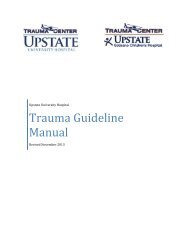10 Alumni Journal - SUNY Upstate Medical University
10 Alumni Journal - SUNY Upstate Medical University
10 Alumni Journal - SUNY Upstate Medical University
Create successful ePaper yourself
Turn your PDF publications into a flip-book with our unique Google optimized e-Paper software.
the Association for the Advancement of Automotive Medicine,<br />
he pushed for seat-belt laws, airbags, and road improvements.<br />
As a result of his work, he was included among 272 honorees in<br />
Esquire magazine’s inaugural register of “Men and Women under<br />
40 who are Changing America” in 1984.<br />
Three years later, Schwab joined the faculty of <strong>University</strong><br />
of Pennsylvania School of Medicine, just as the 9-mm semiautomatic<br />
pistol was released for commercial sale. As a result, the<br />
spectrum of handgun injury changed from single-shot, minimally<br />
destructive wounding to multiple-shot catastrophic wounds,<br />
typically injuring multiple organs.<br />
By the early 1990s, Philadelphia had one of the worst epidemics<br />
of urban firearm injury in the United States, and at times<br />
led the nation in gun homicide. The Hospital of the <strong>University</strong><br />
of Pennsylvania, located in West Philadelphia, was the receiving<br />
center for hundreds of gunshot victims a year, peaking at more<br />
than 500 cases in 1992.<br />
Schwab was uniquely suited to treating such gun violence.<br />
Following medical school at <strong>Upstate</strong>, Schwab joined the U.S.<br />
Navy and did five years of surgical training at the Portsmouth<br />
Naval Hospital in Virginia, where nearly all faculty members had<br />
extensive experience treating combat wounds in Vietnam.<br />
“The very core of surgery at Portsmouth was trauma surgery<br />
and the focus was on how to manage the wounded warrior with<br />
Dr. Schwab looks over a brain scan with a colleague.<br />
“Only through legitimate research will we be<br />
able to identify the root causes of why people<br />
become violent. . . .At the same time, we need<br />
short-term solutions to lower the toll and live safer<br />
in a society that has chosen to live with guns.”<br />
—C. WIllIAM SCHWAB, MD ’72<br />
extensive injuries,” he says. He learned ballistics and triage—how<br />
to make very important decisions about life and death (and to be<br />
comfortable with it) with a minimum amount of data.<br />
It was perfect training for being a future inner-city trauma<br />
surgeon. The only problem was Philadelphia wasn’t supposed<br />
to be a combat zone. Many of the deaths he saw were entirely<br />
preventable. “The number of deaths of young, African-American<br />
males was moving, to say the least,” Schwab says. “All these kids<br />
who had just a few years earlier been seventh or eighth graders<br />
were now dead on the operating room table.”<br />
As a responsible physician, Schwab says he couldn’t continue<br />
to just fix the anatomical injuries and turn the kids back out on<br />
the street. “After awhile, you’ve got to ask, ‘Why is this happening,<br />
and how can we get it to stop?’” says Schwab, whose<br />
research helped inform the passage of the 1993 Federal Brady<br />
Bill requiring background checks for gun buyers.<br />
Schwab viewed the situation as a military surgeon would.<br />
“You have to know something about the war you’re fighting,”<br />
he says. He turned to data on firearm injury as a start. The only<br />
problem was that the data did not exist.<br />
“That was unusual,” says Schwab, considering such statistics<br />
were readily available for death from causes such as motor vehicle<br />
accidents, infectious disease, or drowning. In terms of firearm<br />
injury, the most detailed available information was the FBI<br />
Uniform Crime Reports, because they recorded every crime by<br />
firearm. Although the availability of data has improved, partly<br />
due to FICAP’s efforts, assembling comprehensive data on<br />
firearm injury in the United States remains a challenge. FICAP<br />
helped develop and support the implementation of the Center<br />
for Disease Control’s (CDC) National Violent Death Reporting<br />
System (NVDRS) that is now active in 16 states to study<br />
patterns and risk factors for all violent injury.<br />
In 1997, Schwab and colleague Therese Richmond, PhD,<br />
Associate Professor of Nursing at Penn, created FICAP. They<br />
<strong>10</strong> A l U M n i J o U r n A l / s P r i n g 2 0 1 0

















